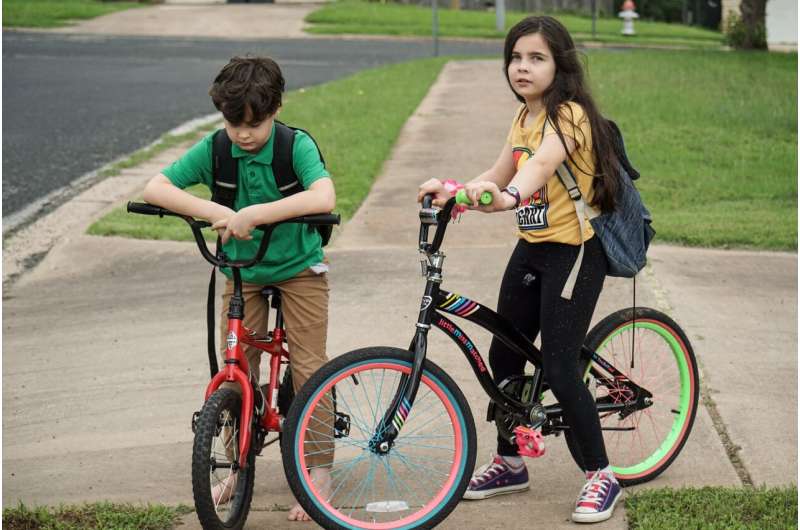This article has been reviewed according to Science X's editorial process and policies. Editors have highlighted the following attributes while ensuring the content's credibility:
fact-checked
trusted source
proofread
Mitigating barriers for children walking and biking to school

Nearly 20 years ago, the U.S. Congress approved funding to implement the Safe Routes to School (SRTS) program across the country. SRTS promotes safe and accessible active transportation, like walking or biking, for students to school through infrastructure improvements, safety education, safety enforcement and incentives.
Despite the demonstrated physical and mental health benefits of active transportation to children—and advantages granted to school districts and local neighborhoods by the program—many economically disadvantaged communities do not implement it. Researchers from Penn State's Department of Kinesiology have now learned why that might be and has proposed solutions to mitigate such barriers.
The researchers previously identified barriers these populations face, such as lack of personnel, financial means and education in grant writing and the implementation process.
To better understand these barriers and to develop strategies to mitigate the challenges and promote active transportation within these communities, the researchers interviewed 13 SRTS state representatives and coordinators from across the country.
Led by Lucas Elliott, who graduated with a bachelor's degree in kinesiology in 2019 and a doctorate in kinesiology in 2022, and Melissa Bopp, professor of kinesiology and professor in charge of the undergraduate program in kinesiology, the researchers published their findings and recommendations in the Journal of Transport & Health.
"Programs like Safe Routes to School are successful in increasing the number of children who walk and bike to school safely, but program representatives noticed that many disadvantaged neighborhoods were not utilizing this program," said Elliott, who also received his master of public health in community and behavioral health from the Penn State College of Medicine and his doctorate in psychology of behavior from Penn State.
"We wanted to better understand why underrepresented communities were not applying to this program and what strategies the SRTS program could use to help facilitate their participation."
The researchers found that there are several factors contributing to the persistence of each barrier—including that many simply do not know about the program.
"One key finding is the lack of awareness of the Safe Routes to School program," Bopp said. "These schools don't know this resource is available to them, or they don't understand how it can benefit their students and communities. Those who do lack the support and resources to write the grant proposals necessary to apply for the program."
This program relies on schools to develop and write grant proposals that outline the problems that prevent safe access for students to travel to school via walking or biking, the funding and resources needed to resolve these issues, and the proposed strategy to implement the program.
Higher-income communities are more likely to have volunteers or personnel with skills in grant writing or be able to hire consultants to write the grant proposals, but many disadvantaged communities lack the resources to do the same.
One way to mitigate this barrier, the researchers suggested, would be for SRTS to proactively reach out to schools in disadvantaged neighborhoods rather than to wait for the schools to apply for a grant.
The researchers also recommended changing the way that SRTS programs are funded as a way to improve access to biking and walking to school for all children. How these programs are currently funded relies heavily on each individual state's legislation and political priorities, so program implementation can vary widely between states.
"Establishing a funding and resource baseline for these programs, whether that is through federal policies or another method, would give these leaders and coordinators equal footing to assist disadvantaged communities," Bopp said.
The researchers pointed to untapped resources to further reduce barriers.
Many members of disadvantaged communities often work multiple jobs or live in single family households, which prevents them from being able to offer their time as volunteers. High school students and members of different organizations may have community service requirements that could be used to help ease the burden on the others in the neighborhood.
Public health officials and consultants could also help mitigate challenges, according to the researchers. They suggested that such individuals could leverage their experience and help SRTS program leaders and coordinators better understand how to reach disadvantaged communities to make their programs successful and sustainable.
"Many program leaders and coordinators noted that they lack the expertise or experience necessary to know how to better reach these schools," Bopp said. "Their backgrounds are primarily rooted in engineering, so they have the knowledge to bolster the supporting infrastructure of SRTS programs but lack the experience to apply the same attention to the educational and outreach aspects of the programs."
SRTS coordinators should also consider developing partnerships with other government agencies and external community organizations to support and expand the reach of the program, the researchers said.
Government agencies and community organizations that provide services to disadvantaged communities have established connections with them and may provide opportunities to promote SRTS programs and the benefits of walking and biking to school for children's health.
"Programs like the Safe Routes to School program have the potential to help children create life-long habits that benefit their overall health while also providing them with the education and infrastructure to do so," Elliott said.
"Making these programs more accessible and equitable for disadvantaged communities will allow more children and community members to utilize alternative transportation options and develop healthy habits."
More information: Lucas D. Elliott et al, Barriers and strategies to implementing safe routes to school programs within disadvantaged communities: Interviews with state-level representatives, Journal of Transport & Health (2024). DOI: 10.1016/j.jth.2024.101800
Provided by Pennsylvania State University




















